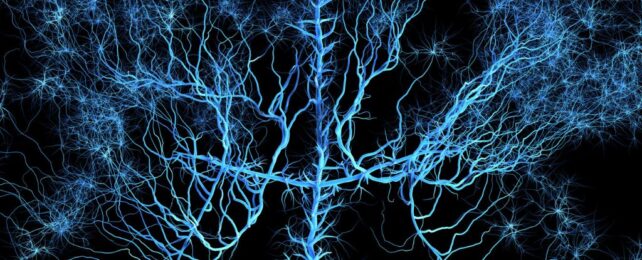The human brain is said to be the most complex object in the known Universe. Its 89 billion neurons each have around 7,000 connections on average, and the physical structure of all those entities may be balanced precariously on a knife's edge, according to a new study.
Two physicists at Northwestern University in the US – Helen Ansell and István Kovács – have now used statistical physics to explain the complexity seen in a highly detailed 3D map of not just part of a human brain, but part of a mouse's and fruit fly's brains as well.
At a cellular level, their framework suggests the high-level hardware encased in our skulls is at a structural sweet spot closely approaching a phase transition.
"An everyday example of this is when ice melts into water. It's still water molecules, but they are undergoing a transition from solid to liquid," explains Ansell.
"We certainly are not saying that the brain is near melting. In fact, we don't have a way of knowing what two phases the brain could be transitioning between. Because if it were on either side of the critical point, it wouldn't be a brain."
In the past, some scientists have suspected that phase transitions play an important role in biological systems. The membrane that surrounds cells is a good example. This lipid bilayer fluctuates between gel and liquid states to let proteins and liquid in and out.
By contrast, however, the central nervous system may teeter on a critical point of transition, while never actually becoming something else.
A common feature of this critical point is the branch-like structure of neurons, known as fractal patterns. Fractals, like those seen in snowflakes, molecules, or the distribution of galaxies, emerge in the most complex of systems. In physics, the fractal dimension is a "critical exponent" that sits on the edge of chaos, between order and disorder.
Ansell and Kovác now argue that the nanoscale presence of fractals in 3D brain reconstructions is a sign of this 'criticality'.
Because of data limitations, the duo were only able to analyze a single partial brain region of a human, a mouse, and a fruit fly. Yet even with this limited picture, the team found matching fractal-like patterns that looked similar regardless of whether they zoomed in or out.
The relative size of various neuron segments and their diversity seem to be maintained across scales and species. Neither too organized nor too random, the brain's systems are juuuust right, balancing the costs of neural 'wiring' with the requirements of long-distance connections.
This 'Goldilocks effect' could very well be a universal, governing principle of all animal brains, Ansell and Kovács argue, although proving that will require far more research.
"Initially, these structures look quite different – a whole fly brain is roughly the size of a small human neuron," says Ansell. "But then we found emerging properties that are surprisingly similar."
Further studies are now needed to determine if that shared criticality exists across the full scale of the animal brain and among various species.
While previous studies have analyzed brain criticality when it comes to neuron dynamics, it hasn't been possible until recently to analyze and compare the structure of animal brains at a cellular level.
Data limitations still exist, of course, but there is currently a large-scale effort in neuroscience to map the anatomy and connections of the brain in as much detail as possible.
A single cubic millimeter of a human brain was recently reconstructed, and last year, we got the first-ever complete map of a fruit fly brain, as well as a cellular map of the mouse brain.
"[The structural level] has been a missing piece for how we think about the brain's complexity," says physicist István Kovács from Northwestern.
"Unlike in a computer where any software can run on the same hardware, in the brain the dynamics and the hardware are strongly related."
Ansell says the team's findings "open the way" to a simple physical model that can describe statistical patterns of the brain. One day, such a feat could be used to improve brain research and to train artificial intelligence systems.
The study was published in Communications Physics.
